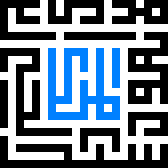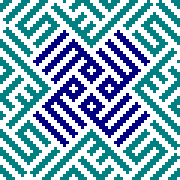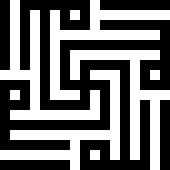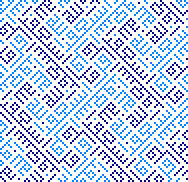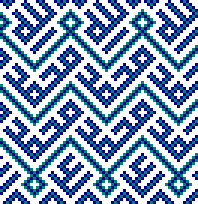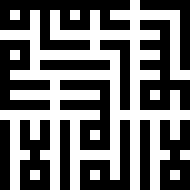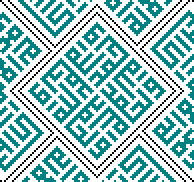Square Kufic in Architecture
Square Kufic in architectural settings by country.
Afghanistan
Abdullah Ansari Shrine Complex
Patterns of square kufic from the Abdullah Ansari Shrine Complex, Herat, Afghanistan. The complex is a funerary compound (hazira), containing the tomb of the Sufi mystic and saint Khwajah Abdullah Ansari who died in 1098. The shrine enclosing the tomb was commissioned by Timur, and completed by Architect Qavam al-Din Shirazi in 1425.
The Mausoleum of Gawhar Shad is located in the western corner of the Madrasa Gawhar Shad, Herat. It was completed in 1432 CE (835 AH). A year after completion Gawhar Shad's son Baysunghur was buried in the mausoleum. Gawhar Shad is believed to have been buried in the mausoleum, also seven princes from the Timurid period.
Khwaja Abu Nasr Parsa Shrine, Balkh
The Khwaja Abu Nasr Parsa Shrine in Balkh, is thought to have been built for Khwaja Abu Nasr Parsa (died CE 1460), who was a spiritual leader of the Naqshbandi order in Sufism and a theological lecturer in Herat, but there is no historical proof that the shrine was dedicated to him. The date CE 1598 written on the drum of the building is certainly from a restoration as the building itself is clearly from the Timurid period.
Azerbaijan
Tomb Tower at Barda, Azerbaijan
The tomb tower at Barda was erected in CE 1323 (722 AH), by a builder named Ahmad bin Ayyub al-Hafiz of Nakhichevan. Locally it is said to be the Mausoleum of Ahmad Zocheybana. The village of Barda used to be an important town in the tenth century and became a resort for the Il-Khanid rulers, who had their provincial capital at Maragha. The cylindrical brick structure is similar to other tombs in the wider area. The building is 14 meters high. The conical roof is a modern addition.
Gudi Khatun Mausoleum, Karabaghlar, Azerbaijan
The Gudi Khatun Mausoleum was built for Jehan Gudi Khatun between 1335 and 1338, by the Ilkhanid ruler Abu Said Bahadur Khan (1316-1335).
China
The Mausoleum of Tughluq Temur, who ruled Mogholistan, is located in Huocheng, Xinjiang. It was built in 1363 upon the death of Tughluq Temur Khan (1359-1363).
Iran
The Allah Allah dome part of the Sheikh Safi Mausoleum in Ardabil
The Mausoleum of Sheikh Safi, in Ardabil, was built by his son Sheikh Sadraddin, after Sheikh Safis death in 735 AH (CE 1334). The Allah Allah dome covers the resting place of Sheikh Safi, and was one of the first parts of the mausoleum complex.
The Nizamiyya Mosque at Abarquh was built during the Il-Khanid period, in CE 1325. All that is left today are the remains of two minarets.
A large building, built around 1330-50, only fragments remain.
Shaykh Abd al-Samad Shrine Complex, Natanz
The shrine complex for 'Abd al-Samad, a shaykh a Sufi of the Suharwardi order, was developed after his death at Natanz in CE 1299 by the vizier Zayn al-Din Mastari. The complex has become one of the best-preserved Il-Khanid shrine complexes surviving today.
Shahzade Hossein Tomb Complex, Qazvin
The Shahzade Hossein Tomb Complex was built during the Safavid period.
Square kufic pattern from the mirhab of the Jameh mosque in Yazd. The building was established in the 12th century with many additions through several building phases.
The Mir Chaqmaq Mosque, also known as the Masjid-e Nau, used to be part of a large complex consisting of a madrasa, khanaqah, caravanserai, qanat, public baths and a maidan. Today only the mosque and maidan remain. The mosque was built during the Timurid era under Shah Rukh, by the governor of Yazd, Jalal Al-din Chaqmaq Shami. Construction began in CE 1436-1437 and was completed some years there after.
The Madrasa al-Ghiyasiyya was built between 842-848 AH (CE 1438-1444). Designed by the outstanding architect, designer and engineer Qavam ad-Din ibn Zayn ad-Din Shirazi who died in 842 AH (CE 1438). The madrasa was the last building that Qavam ad-Din was responsible for, and is gem of the high Timurid style, and one of the best preserved.
The Imam Reza shrine is a mausoleum of the eighth Imam of Twelvers, Imam Ridha. At the end of the 9th century a domed building was built at the site. For more than one millennium the site has been destroyed and rebuilt several times, the site was also expanded. In 1418 CE, the wife of Shah Rukh, Goharshad financed the construction of a beautiful mosque next to the shrine, known now as Goharshad Mosque. The complex today houses a museum, library, cemetery, mosque and some other buildings, and between 15 to 20 million pilgrims visits the shrine every year.
Pir-i Bakran, Linjan, is the tomb shrine of Muhammad ibn Bakran, a Sufi theologian that used to teach at the site. After his death in CE 1303 the building became his mausoleum and shrine.
The Friday Mosque at Isfahan, has had continual construction, reconstruction, additions and renovations from around 771 to the end of the twentieth century. The mosque is regarded as the masterpiece of Persian Architecture.
The Hakim mosque was built during the Safavid period under the reign of Shah Safi and Shah Abbas II between the years CE 1641 to 1663 (1051 to 1073 AH), financed by Doctor (Hakim) Daud. The architect was Mohammad Ali Ibn Ostad Ali Beik. The mosque is situated near the bazaar.
Shaykh Lutfallah Mosque, Isfahan
The Mosque of Shaykh Lutfallah was built under Shah Abbas I and is considered to be a masterpiece of Safavid architecture. The architect was Ustad Muhammad Riza B. Husein and the mosque was erected between CE 1603 to 1619. The building is octagonal with a shallow dome held up by eight pointed arches forming squinches. The dome is decorated with bands of almond shapes that spiral in towards the middle diminishing in size.
The Imami Madrasa is located in the Jubara quarter of Isfahan. Dated to CE 1325, it is important as one of the earliest madrasas in Iran still in existence and even now functions as a madrasa. The madrasa is associated with the tomb of a theologian named Baba Qasim, which was erected by Abu al-Hasan al Talut al Damghani in CE 1340-41.
Ismail Mausoleum and Isaiah Mosque, Isfahan
The Ismail Mausoleum and Isaiah Mosque were developed during the Seljuq till late Safavid rule. The complex consists of an Isaiah mosque with minaret, and a Safavid period shrine to the grandson of the second Imam Hasan, Ismail.
The Nimavard madrasa.
The Sareban Minaret, also known as the minaret of the camel driver, is a perfect example of a free-standing brick minaret from the twelfth century Seljuk period of central Iran. The minaret is 48 meters high, and was built between CE 1130 to CE 1155. The minaret was probably part of a mosque complex, now gone. Over time the minaret has acquired a visible tilt to the west.
The Gar Minaret and Mosque date from the Il-Khanid period and where built in CE 1121-22. The mosque and minaret have mostly collapsed, but some banna-i decoration is still present.
Shaykh Zayn Al-Din Mausoleum, Taybad
Shaykh Zayn Al-Din Mausoleum, Taybad.
Kazakhstan
Ahmad Yasawi Mausoleum, Jassy, Kazakhstan
This memorial and shrine complex was built by Timur between 1389 and 1399, over the tomb of the Sufi saint Khoja Ahmad Yasawi.
Turkey
Zeynel Bey mausoleum, Hasankeyf
The Zeynel Bey mausoleum is the tomb of the eldest son of the Turkmen Uzun Hasan, Zeynel Bey. It is situated on the north bank of the Tigris from the city. The tomb was built by the architect Pir Hasan, after Zeynel Bey had fallen in battle CE 1473.
Hasankeyf Kizlar Camii Minaret, Hasankeyf
The Hasankeyf Kizlar Camii Minaret is the only part of this mosque still standing.
The Çifte (double) Minaret Madrasa in Sivas was built in CE 1271 by the Ilkhanid Vizier Semseddin Cuveyni (Shams al-din Juwayni). Originally the madrasa would have had four iwans around a courtyard surrounded by a two-story building. All that remains today is the façade with the two minarets.
Uzbekistan
Aq Saray palace, Shahr-i Sabz, Uzbekistan
The Aq Saray palace in Shahr-i Sabz, was built Timur. Today only the ruin of the entrence portal is left.
Bibi Khanum Mosque in Samarqand
Patterns of square kufic from the Bibi Khanum Mosque at Samarqand, built 1394-1404. Timurs Bibi Khanum Mosque was built to impress with a height of 44 meters. However the building techniques of the time were pushed to the limit which meant that the building began to crumble before it was completed. The building sustained extensive damage from an earthquake in 1897.
Patterns of square kufic from the Dar al-Siyadah Complex, Shakhrisabz, Uzbekistan, built 1375-1404.
Gur-i Mir Mausoleum, Samarqand, Uzbekistan
Timur built this mausoleum for his grandson Muhammad Sultan, who died at battle in 1403. Timur was himself buried in the mausoleum in 1405. The last of Timurs family to be buried at Gur-i Mir was Ulugh Beg.
The Sher Dor madrasa lies at Registan Square in Samarqand. The madrasa was built in the seventeenth century between 1619 and 1636. An inscription attributes construction to Abdul Jabbar and decoration to Mohammad Abbas.
Shah-i Zindah Necropolis, Samarqand, Uzbekistan
The Shah-i Zinda necropolis is a complex containing tombs and mausolea built between the eleventh and fifteenth centuries, centered around Qusam's, first cousin of the Prophet Muhammad's mausoleum. Timur buried many of his female family members at Shar-I Zinda. Ulugh Beg built a monumental gateway, and a series of terraces in 1434-1435.
Congregational mosque at Dar al-Tilavah Complex Gok Gunbad, Shakhrisabz
Congregational mosque at Dar al-Tilavah Complex Gok Gunbad, Shakhrisabz.
Turkmenistan
Shrine complex of Jamal al-Din, Anau
The Shrine complex of Jamal al-Din at Anau, Turkmenistan, was built between CE 1447-1457, during the reign of Abul-Kasim Babur. The complex had two minarets and two domes. Above the entrance, there was intricate mosaic work depicting two large yellow dragons against a blue background. In 1948 the area was struck by a massive earthquake, the shrine was reduced to rubble. Some of the mosaic have been recovered, like the dragons over the entrance portal, and are now housed at the Fine Arts Museum of Ashgabat, some 12 km from the shrine.
 Square Kufic in Architecture
Square Kufic in Architecture
